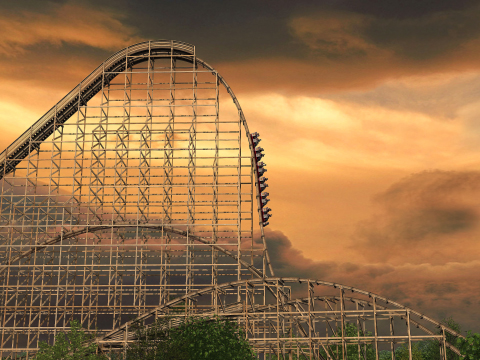When we work with teachers to shift toward concept-based instruction things tend to follow a distinct pattern, a roller coaster that flows from over-excitement to near abandonment and back again.

image credit: gannett-cdn.com
First, there is incredible eagerness and enthusiasm. This makes so much sense! YES! I’ve always felt like my curriculum was too shallow! Show me more! I can’t wait to try this out!
This enthusiasm propels teachers to dig into the framework that holds their discipline together, to think big complex thoughts, to plan ambitious units and lessons. Wow! I can’t wait for kids to read To Kill a Mockingbird, watch a video on the “New Jim Crow,” and investigate historical photographs and develop their own theories about race, power, and justice. This is going to blow their minds! We are going to change the world!
Then there’s often a steep crash after the first few concept-based lessons. They aren’t getting this! No matter what I do, they don’t understand the book and their ideas about race/power/justice are still so naive! We’re so behind! These conceptual lessons are too frou-frou – where’s the rigor?
And…a return to teaching facts and procedures in isolation aka the Comfort Zone. I’ll just get through these basics and then we’ll pull it all together with the concepts at the end of the unit. If we focus on the story now, they can write their final essay about race/justice/power.
The problem, we’ve found, is that concept-based curriculum and instruction are SO alluring to teachers that they are crushed when reality doesn’t match their vision. They imagine a classroom where kids are operating on all conceptual cylinders all the time, applying concepts flexibly and insightfully so that every class is one long series of epiphanies.
Why doesn’t it work this way? One obvious reason is that kids are lousy at synergistic thinking – moving between factual and conceptual understanding in a mutually reinforcing way. Actually, I should qualify that statement. Kids’ brains are performing synergistic thinking all the time, but they’re rarely asked to do it consciously and in a disciplined way. Moving between facts — the story they’re reading, the historical examples they’re studying — and concepts — the larger ideas, patterns, and lessons — takes practice.
What does this mean for teachers who aspire to a concept-based classroom? For one, it means that you may need to ease kids into concept-based learning by devoting significant time to modeling and guiding them through this thinking with “training wheels.”
Here is one approach that might help kids take control of synergistic thinking: build mental models up AND DOWN the structure of knowledge.

credit: Lynn Erickson
Once kids are practiced in synergistic thinking, we expect them to build generalizations and theories that explain the relationship among concepts, and to support those generalizations with a strong base of factual examples. For instance, students studying the American Revolution may read Thomas Paine’s Common Sense and investigate Paul Revere’s engraved depiction of the Boston Massacre. They might research the impact of these two sources on colonial Americans. The teacher may ask students: What is the relationship between power, change, and propaganda? And students might build ideas “up” the structure of knowledge, using the facts to generalize that “People in power can unite diverse groups for or against change using propaganda.”
But kids who haven’t practiced this kind of thinking before usually find it easier to break ideas “down” by starting with a generalization and figuring out how examples and facts support it. Think of it kind of like looking in the back of the book for the answer to a problem and then figuring out how to get there.
One of my favorite examples of this type of “crutch” is to provide a very loose generalization as a framework that kids can apply over the course of many units or even the entire year, pushing them to refine it along the way. For instance, a history teacher I know uses the framework:
injustice –> challenge –> change to balance of power
Whether they’re studying the Reformation or Haitian Revolution or BlackLivesMatter, knowing that a pervasive injustice often leads people to challenge the status quo, which in turn shifts the balance of power among groups in society, is a powerful mental model. Anytime kids see any part of this equation they know that the other two parts are probably at work as well. Notice a shift in power? Look for an injustice at the root of the change. Notice a group challenging the status quo? A change in the balance of power is likely to follow.
You can teach a model like this “top-down,” meaning that you, the teacher, can explain this generalization first and ask kids to work their way back down to show how factual examples support the pattern. Early in the year, this may be an appropriate entry point.
As the year progresses, though, students learn to work their way “up” the structure of knowledge to refine this generalization. What happens if the injustice primarily impacts a minority group? When does a challenge to the status quo result in a more equal distribution of power? When does it result in greater disparities in power among groups? When does a challenge to the status quo “backfire”? You get the idea.
The beauty of this approach is that students get to come back to the same conceptual relationships again and again, increasing the sophistication of their thinking over the course of the year. Instead of moving on from one concept to the next, leaving kids’ thinking underdeveloped, there is time for kids to develop insights at their own pace.
Keep in mind, though, that the ultimate goal is for students to build and defend their own generalizations, and to test their own generalizations through application to new situations. Eventually, all kids can and should get there!
